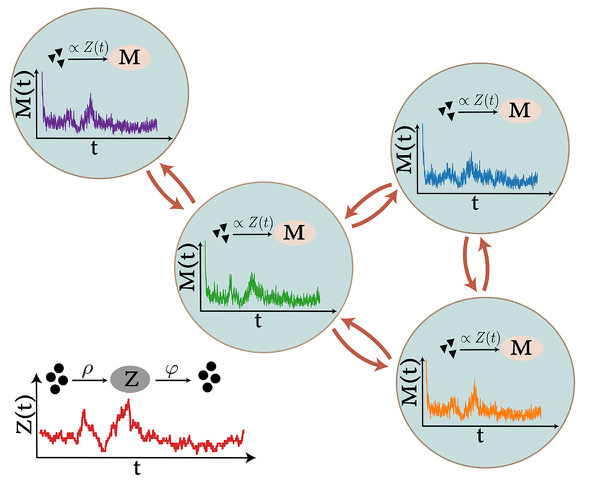
A random environmental signal Z(t) is estimated by each cell using their internal sensor molecule M(t), which can be transported to neighboring cells to exchange information and enhance the quality of estimations © Bahadorian et al. MPI-CBG/CSBD
In biological systems cells need to estimate their environmental signals to make reliable decisions and to perform their functions properly. For example, an epithelial tissue that outlines the surface of organs must decide whether to react to a given external concentration of stress-signaling molecules.
The dynamic signal sensing (= when signal concentration changes over time) by a single cell and the static signal sensing in cell communities (e.g. with all-to-all communication) have already been analyzed. However, a theoretical framework to study the estimation of a dynamic signal by many cells communicating through a complex network was missing so far.
The Carl Modes group together with Christoph Zechner, both research group leaders at the Center for Systems Biology Dresden and the MPI-CBG, have now developed a theoretical model describing the impact of cell communication to the precision of signal estimation. In their paper recently published in Physical Review Research the researchers show that when noise in the system solely arises from random chemical reactions, communication only increases the speed of achieving agreement while leaving the final precision of estimation unchanged. However, when variability in the tools used by each cell for signal interpretation (= cell-to-cell variability) is contributing to the overall noise, the communication of a cell with its neighbors increases the precision of the estimation.
Mohammad Bahadorian, PhD student in Carl’s group, and first author of the study says: "It’s very interesting that when the reaction parameters in each cell are randomly set, cells sharing their different assessments enhances the precision of their estimation. It’s like comparing it to scientists: one can consider them as different elements in a community that are trying to gather information about an unknown process. Their equipment and methods are different, but when they start to communicate and exchange their results, it really improves the general understanding of that phenomenon.”
Carl Modes, who supervised the work adds: “There is a clear application to biology, where for example a group of cells in a developing embryo need to estimate an environmental signal and make a decision with the highest possible reliability at a finite time. Our results can also have implications on any other system in which communicating elements share their noisy readouts to have a better estimation of an unknown signal.”
Mohammadreza Bahadorian, Christoph Zechner, and Carl D. Modes: "Gift of gab: Probing the limits of dynamic concentration-sensing across a network of communicating cells" Phys. Rev. Research 2, 023403,
Published 25 June 2020. DOI: doi.org/10.1103/PhysRevResearch.2.023403